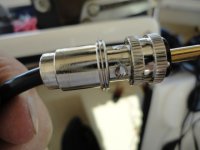My recollection is that for the demo I did in the photos I used a 40 watt soldering iron. You don't want to get the whole fitting too hot--and you and one of the reasons to use a vice, is for that to be a heat sink. I used a machinists drill press vice in the demo--THT link used a bench vice--either type will work. You may also want to put some heat sink on the tip--such as a hemostat on the tip--you don't want to melt the insulation. With the trick of pre soldering the braid to the adaptor fitting, you can use much less heat when you solder the barrel to the adaptor (to the RG 58 in your case). A mistake which many make is to get the whole barrel too hot, and insulation melts. You want a smooth flow of the solder, but just around the hole--not over the entire barrel. You can use a higher power iron, with less contact time, or click the 100/140 iron on and off to get the right amount of heat--I have done that--and the 100/140 iron is very versatile. Don't use 300 watts however.
I have an assortment of soldering irons--they all last a long time and have other uses. There are two Weller two heat Guns--one is the 200 to 300 watts, for really heavy and fast work, The other is the 100 to 140 watts, and that is the one I have used the most. It is about 40 years old. I put new tips on it and it still keeps on working! I have an assortment of tips--and use it for hot knifing acrylic fabrics, putting holes in fabrics, to seal the edges etc.
Then I have several of the pencil type (I don't have the fancy soldering station)--one is 15 watts for circuit boards, there is a 40 and an 80 watt pencil type with chisel tips. I also have a Portasol which is 25 to 75 watts, and is handy if you have to solder away from electrical power--like at the top of a 65 foot mast on a sailboat! It uses a propane cartridge to provide the heat. I also have several of the torches, from a mini up to an oxygen/ mapp gas (silver solder and very light brazing), with various tips. All of these give goo much heat for me to use for soldering the PL 259.
Also tips have to be cleaned, and occasionally reshaped with a file. You can use a "sponge" or cloth to clean the trip--and keep the tip well soldered. Of course only use resin core solder when working on electronics.
The other question not answered is about wire tying the VHF and Radar cables. Probably OK--I have seen problems with the sonar and VHF cables. A lot depends on what is sent thru the cable. For example the Garmin now do most of the computing in the dome, so you have basically a ether-net cable. If I was worried, I would do a mock up before mounting, and see if there is interference. (If the radar is already in, just tape the VHF cables next to the lower Radar cables, and key the mic with the radar running to see if there is interference. My guess is that it is possible you might have some Radar interference during a VHF transmission. I try and keep the antenna/transducer cables separate, not close or parallel.

